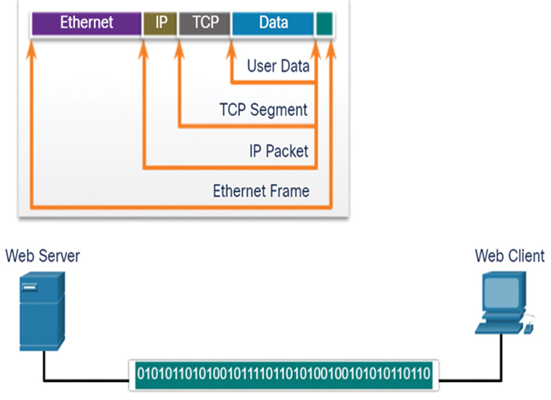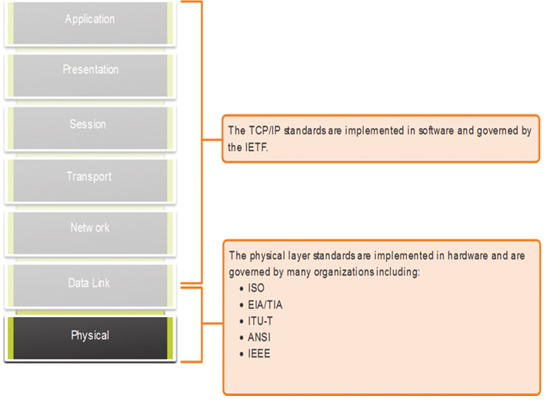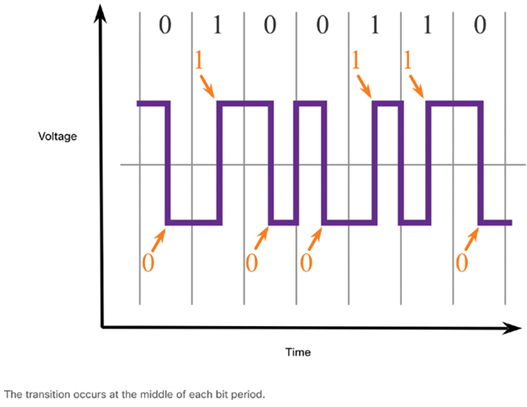The OSI physical layer provides the means to transport the bits that make up a data link layer frame across the network media. This layer accepts a complete frame from the data link layer and encodes it as a series of signals that are transmitted to the local media. The encoded bits that comprise a frame are received by either an end device or an intermediate device.
Figure 30-4 show an example of the encapsulation process. The last part of this process shows the bits being sent over the physical medium. The physical layer encodes the frames and creates the electrical, optical, or radio wave signals that represent the bits in each frame. These signals are then sent over the media, one at a time.
The destination node physical layer retrieves these individual signals from the media, restores them to their bit representations, and passes the bits up to the data link layer as a complete frame.

Figure 30-4 Bits Transported Over the Medium
Refer to the online course to view an animation of the encapsulation process.
Check Your Understanding – Purpose of the Physical Layer (30.1.3)
Refer to the online course to complete this Activity.
Physical Layer Characteristics (30.2)
At the foundation of network communications is the physical layer, Layer 1. This topic examines standards and components that make up the physical layer.
Physical Layer Standards (30.2.1)
In the previous topic, you gained a high level overview of the physical layer and its place in a network. This topic dives a bit deeper into the specifics of the physical layer. This includes the components and the media used to build a network, as well as the standards that are required so that everything works together.
The protocols and operations of the upper OSI layers are performed using software designed by software engineers and computer scientists. The services and protocols in the TCP/IP suite are defined by the Internet Engineering Task Force (IETF).
The physical layer consists of electronic circuitry, media, and connectors developed by engineers. Therefore, it is appropriate that the standards governing this hardware are defined by the relevant electrical and communications engineering organizations.
There are many different international and national organizations, regulatory government organizations, and private companies involved in establishing and maintaining physical layer standards. For instance, the physical layer hardware, media, encoding, and signaling standards are defined and governed by these standards organizations, as shown in Figure 30-5:
• International Organization for Standardization (ISO)
• Telecommunications Industry Association/Electronic Industries Association (TIA/EIA)
• International Telecommunication Union (ITU)
• American National Standards Institute (ANSI)
• Institute of Electrical and Electronics Engineers (IEEE)
• National telecommunications regulatory authorities including the Federal Communication Commission (FCC) in the USA and the European Telecommunications Standards Institute (ETSI)

Figure 30-5 Physical Layer Standards Organizations
In addition to these, there are often regional cabling standards groups such as CSA (Canadian Standards Association), CENELEC (European Committee for Electrotechnical Standardization), and JSA/JIS (Japanese Standards Association), which develop local specifications.
The physical layer standards address three functional areas:
• Physical Components
• Encoding
• Signaling
The physical components are the electronic hardware devices, media, and other connectors that transmit the signals that represent the bits. Hardware components such as NICs, interfaces and connectors, cable materials, and cable designs are all specified in standards associated with the physical layer. The various ports and interfaces on a Cisco 1941 router are also examples of physical components with specific connectors and pinouts resulting from standards.
Encoding or line encoding is a method of converting a stream of data bits into a predefined “code”. Codes are groupings of bits used to provide a predictable pattern that can be recognized by both the sender and the receiver. In other words, encoding is the method or pattern used to represent digital information. This is similar to how Morse code encodes a message using a series of dots and dashes.
For example, Manchester encoding represents a 0 bit by a high to low voltage transition, and a 1 bit is represented as a low to high voltage transition. An example of Manchester encoding is illustrated in Figure 30-6. The transition occurs at the middle of each bit period. This type of encoding is used in 10 Mbps Ethernet. Faster data rates require more complex encoding. Manchester encoding is used in older Ethernet standards such as 10BASE-T. Ethernet 100BASE-TX uses 4B/5B encoding and 1000BASE-T uses 8B/10B encoding.

Figure 30-6 Manchester Encoding
